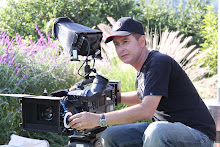
The concept of shooting without tape is still daunting to many. There is a comfort level having a pile of tapes at the end of the shoot day. While understandable, there are so many benefits to ready-to-edit clip-based files that getting past the tape mindset is worthwhile and have been highlighted on this blog previously(see "Going Tapeless").
Here I want to highlight best practices for shooting tapeless. The best approach, based upon years of experience recording onto on-board hard drives(nNovia, FireStore) and memory cards(P2 and SxS), is for the producer or director to bring two external USB or FireWire(FW800 is fastest) hard drives of 160Gb or more capacity to the shoot. SSV can provide the laptop computer with the appropriate file transfer and viewing software. Hard drives are available for rental as well.
That's pretty much it, assuming somebody on the crew is experienced with doing the data transfer. During the course of the shoot day, data can be transferred as each memory card is filled or all can be done at the end of the day during strike--assuming enough memory card capacity is available on-set in the latter example(data transfer could take over an hour, depending on total record time and format).
Some specific technical points worth knowing are: always write-protect the card before inserting it into a laptop slot or card reader, always have a clip viewer designed to playback the clips from the cards prior to data transfer and for playback from the external hard drives once the data transfer is completed. I recommend using software that does data verification during the transfer process, using two drives simultaneously, so that there is a digital clone of all the footage. During the data transfer, low-res Quicktime proxy files with time code display can be generated and uploaded to a server, put on a thumb drive, sent to an iPhone, etc. for fast, convenient dailies. Some popular software applications include P2 Viewer, P2CMS, ShotPut Pro, XDCAM Transfer, XDCAM Browser, Final Cut Log and Transfer and ProxyMill.
Here are the downloads you’ll need for working with P2:
http://www.panasonic.com/business/provideo/support/software.asp
Now, here are the downloads you’ll need if you’re working with SxS cards:
http://pro.sony.com/bbsc/ssr/micro-xdcam/resource.downloads.bbsccms-assets-micro-xdcam-downloads-XDCAMSoftwareDownload.shtml#apps
Your laptop should now be able to recognize your P2 card/SxS card once it’s connected and you have a way to play back the files you’ve created.
Transferring the data to the hard drive is the next step. Can you use the Finder, Explorer or just drag and drop things? Yes. But, look, just go to Imagine Products and buy Shotput Pro. It’s $99, it verifies the data, allows you to copy to multiple hard drives simultaneously, automates the whole process and is absolutely indispensable.
If the above best practices are adhered to, tapeless recording is pretty painless--especially when compared to time consuming real time ingest into a non-linear edit system via an expensive HD VTR. Almost all new professional cameras going forward are tapeless, so it makes sense to embrace the work flow and its benefits--and your editor will thank you for it.


It does take some doing to get over the fact that you will no longer have a "tape on the shelf" for back up, but once you've moved on to tapeless you actually feel better about the security of the medium you've captured on. Now if we could just get some larger, non-spinning hard drives for back-up! Ironic that tape (DLT) is actually the way many back up their hard drives!
ReplyDeleteI agree, Luke, original master tapes can be a warm fuzzy for those used to using it for many years. Reality is that tape formats and their expensive tape decks become obsolete and hard to get part for, plus the average show has elements such as graphics, still images, computer animation that are on a hard drive anyway, so why not put all the elements on the same media for archiving? Two cloned hard drives cost less than a couple of cases of tapes, hold more data and take up less shelf space.
ReplyDeleteThe article on this blog, "P2 Hits its Stride in 2009", outlines the advantages and costs of LTO(DLT) tape backup for those wanting longer term archival.
Professional cameras with tape transports are becoming extinct--there are only a handful of camcorder models left, and all but one reflect old, sub-sampled, 8-bit formats.
betmatik
ReplyDeletekralbet
betpark
tipobet
slot siteleri
kibris bahis siteleri
poker siteleri
bonus veren siteler
mobil ödeme bahis
F8A
شركة تنظيف افران الغاز بمكة
ReplyDelete0ZX6v37uk3